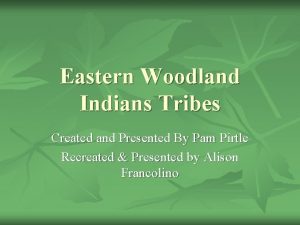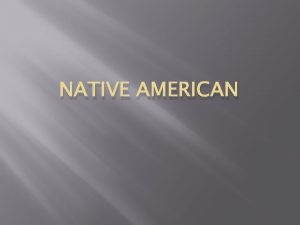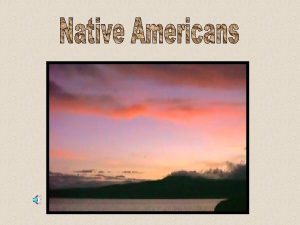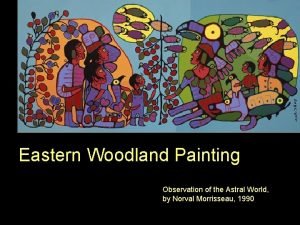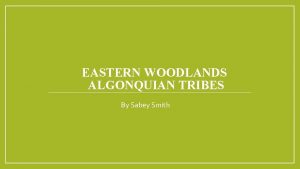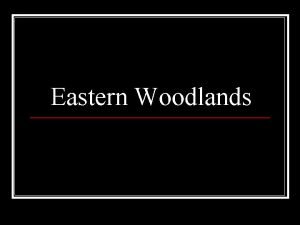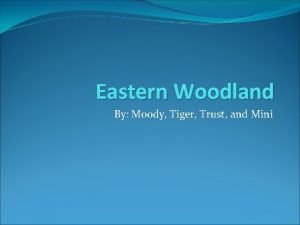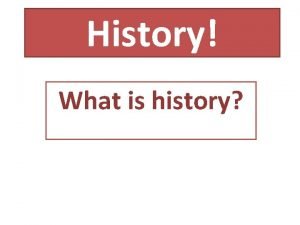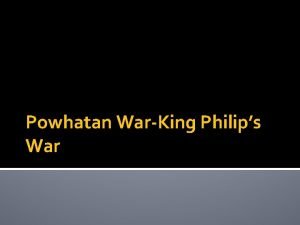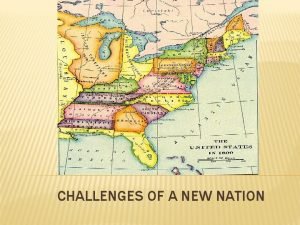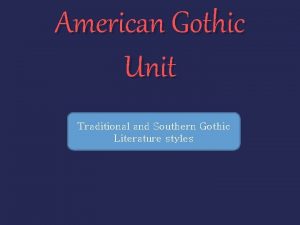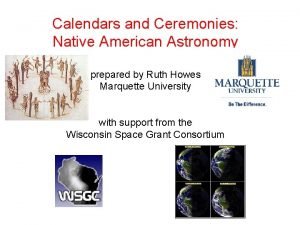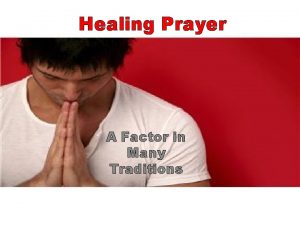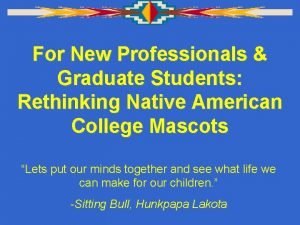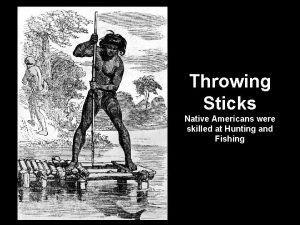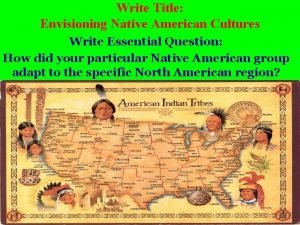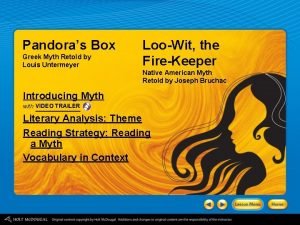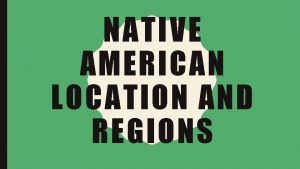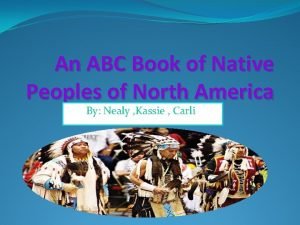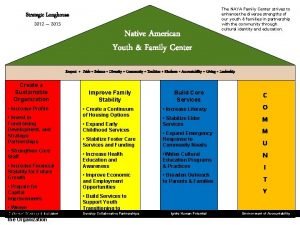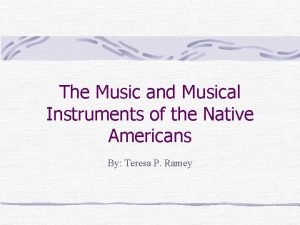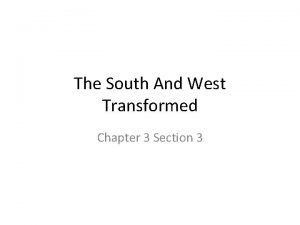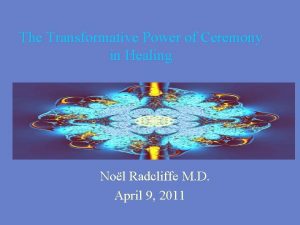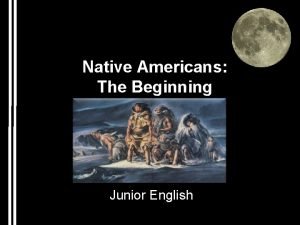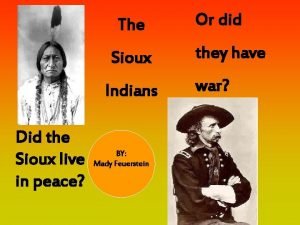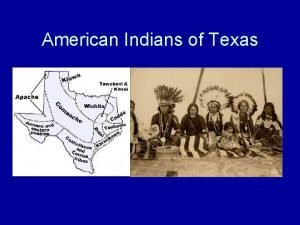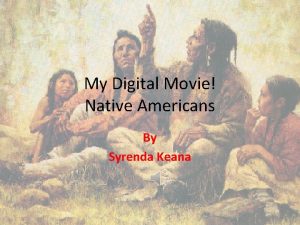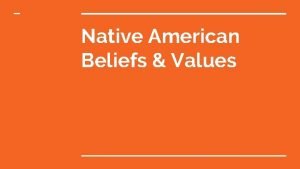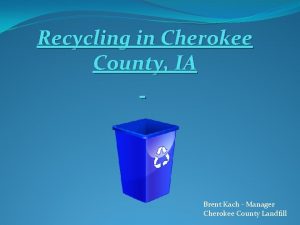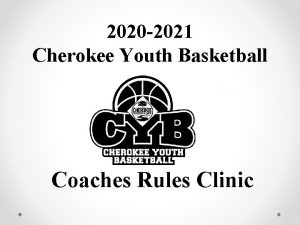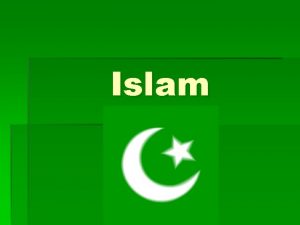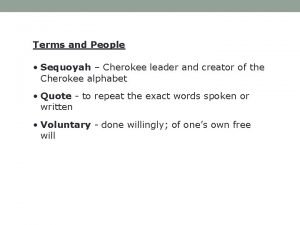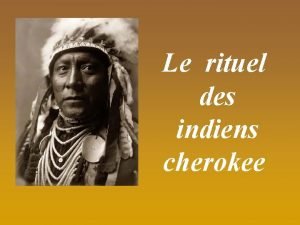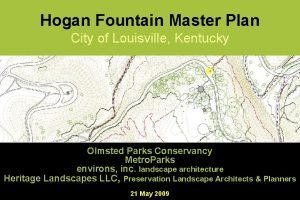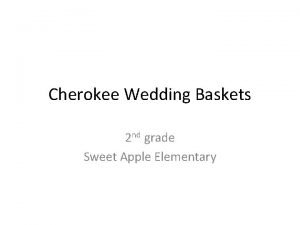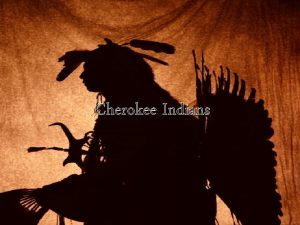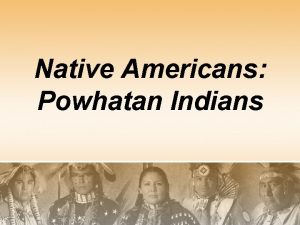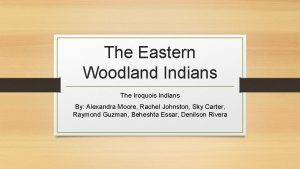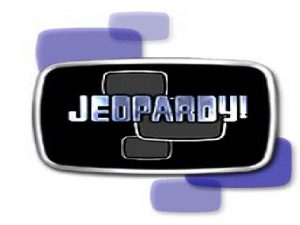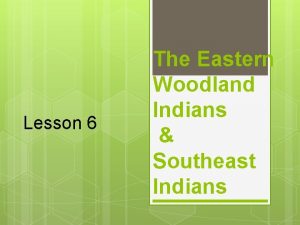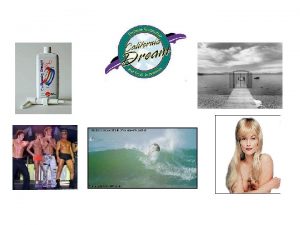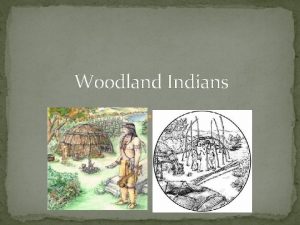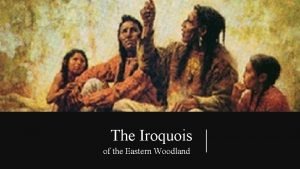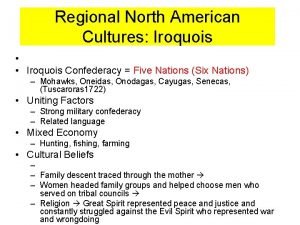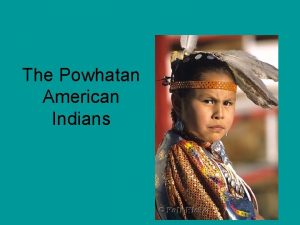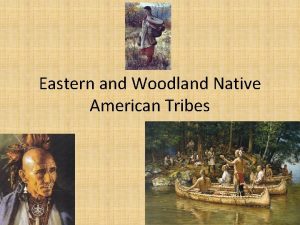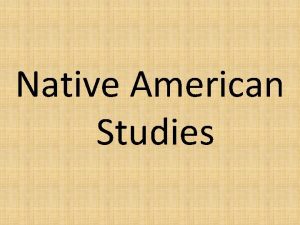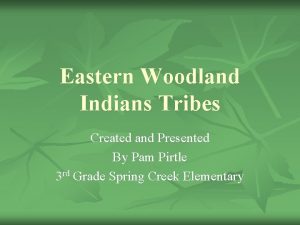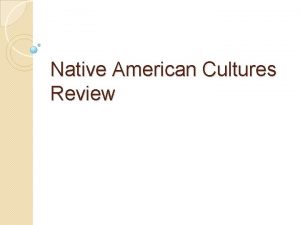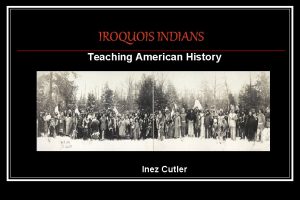NATIVE AMERICAN Eastern woodland Indians Iroquois Powhatan Cherokee

















































- Slides: 49

NATIVE AMERICAN

Eastern woodland Indians � Iroquois � Powhatan � Cherokee Creek �

� � Native American origins Two competing theories A) Tribal histories B) Beringa B) Two developments made migration to Americas possible 1. Human adaptation to frigid environment near arctic circle � 2. Changes in climate � � After migrating north from Asia into Siberia people then migrated over a Land bridge, now submerged, that links Siberia and Canada.

Clovis First � � � 1930 s, archaeologists discovered spear points in the New Mexico town of Clovis dated around 13, 000 years old Individuals who made them have since become known as the 'Clovis people’.

� 'Clovis first‘ proposes that around 14, 000 years ago people travelled across a land bridge that existed between Siberia and Alaska. � Once in North America Journey took them through a corridor that opened up between the ice sheets in Western Canada first to enter the interior of the continent. �

Beringa

� � 1798 Philadelphia French aristocrat Constantin. Francois de Chasseboeuf meets Miami Chief Little Turtle Chasseboeuf notices facial similarities between Little Turtle and Asians and points out small gap between continents ‘Isn’t it possible’ asked Little Turtle that the Tartars, who resemble us so closely, came from America? Why shouldn’t we have been born here? ’

� Questions and conversations such as this occurred frequently in early America, and up to the present day.


Eastern woodland Indians � Iroquois � Powhatan � Cherokee Creek �

Iroquois Creation Myth

How The World Was Made: � Gälûñ'lätï � Dâyuni'sï, "Beaver's Grandchild, " � Great Buzzard � Tsiska'gïlï', the Red Crawfish � Gûlkwâ'gine Di'gälûñ'lätiyûñ', "the seventh height, "

�Tsalagi �A name the Spanish rendered as Chalaque �The English Cherokee


� Early entries into the Cherokee homeland by Spanish � Disease hit the Cherokee at this time � Left Cherokee with time to recover and develop some resistance � Before the English would turn up in the late 17 th and early 18 th Centuries

� Cherokee lived in diverse region � A variety of elevations �From the peaks of Appalachia to the lower levels leading towards the coast � Running through it all was the “Long man” � The Tennessee River

The Cherokee lived in distinct regions � Overhill Towns � Middle Towns � Lower Towns � Occasionally listed as 4 � Valley Towns separated �

� � � The centre of a Cherokee town was the council house 7 Sided 1 for each clan Outside - Uku standard Behind - Treasury

� � � � Blue, or Panther, Clan (Ani. Sahoni) Long Hair Clan ( Ani. Gilohi) Bird Clan ( Ani. Tsisqua) Paint Clan ( Ani Wodi) Deer Clan (Ani Awi) Wild Potato Clan ( Ani Gatogewi) Wolf Clan (Ani Waya) (Eighth clan – left humans to become bears)

Cherokee were Matrilineal � Each clan was descended from an original clan mother � Attakulla talking to the British in 18 th C � “It is customary among [us] to admit women to our councils” � “[Since] the white people, as well as the red, are born of women, is not that the custom among them, also” �

Muscogee (Creek)

� Creek life based around institution of the talwa – town or community �Situated along a stream or a river The society was matri-focal and matri- local � Families often had two houses a winter and summer house along with a storage crib �

� � The center point of each town was the square ground which contained: Four house surrounded the square �Town chief �Warriors �Youths �Assistant to the chief

Ball court � Ceremonial ground � Council house �

� Creek Nation a confederacy � alliance of separate and independent tribes � gradually became, over a long period, a single political organization. � Each town was independent � Yet their organization allowed for temporary loose alliances

Complimentarity not equality � The central aspect of this played out with the gender structure of creek society � “separate people” � Detailed in the Busk ceremony �

During the busk or "poskito. " houses were cleaned and the temple and grounds were repaired. � Fires were extinguished and all debts and grievances were resolved. � People gathered at the ceremonial center for rituals of purification �

� The towns spiritual leader and fire- maker spoke to the community �men inside the square ground �women outside the square � After talking to each group separately � women carried the new fire back to each household � the new year began.

� Gender division also seen in the roles each group took. � Men were warriors and hunters and dealt with external factors � Women were nurturers and growers and held sway of town policy

� There was also a recognized generational split � The mature or old warriors were often more focused on peace whereas the younger warriors were more reckless. � This was more than just youthful rebellion it was a political decision

�Two cars colliding �One just happens to be parked Colonial Contact

� End colonial period � Indians of the eastern woodlands numbered aprox. 150, 000 � The population of British North America doubled every 25 years � Increased 400 percent between 1700 and 1750.

� � � � Not just whites affecting native society Indian people: served in colonial armies as soldiers and scouts traveled to colonial capitals as ambassadors attended colonial colleges as students walked the streets of Colonial towns as visitors came to settlements as peddlers and they worked as slaves, servants, interpreters, guides, laborers, carpenters, whalers, and sailors.

Ecosystems � � Carolina backcountry had begun to ‘wear a new face” by the 1760 s As colonists carved farms and fields out of the forest.

� � For Indian people new world that Europeans created also a graveyard. Smallpox, plague, measles, influenza, pneumonia, tuberculosis, diphtheria yellow fevers Took hold in Indian America

� World in wake of European contact also one of unprecedented violence. � Social disruption created random individual violence � warfare reached new levels of intensity. � Indians fought each other for access to European guns

� Warfare became common �created a stereotype of Indians as warlike European eyes justified treating them as ‘savages. ’ � In a world of escalating violence, war chiefs rose in status as civil chiefs lost influence. � Chiefs struggled to maintain peace � �knowing the alternative was a bloodbath.

� Alcohol deafened young men to the wisdom of their elders � leaders lamented their inability to control their warriors in this new world of chaos

Indian country world of villages, bands, and clans � need to deal with distant capitals demanded unified responses at a time when traditional structure often in flux. � As traditional bases of power weakened, � European agents and traders cultivated client chiefs � giving medals and gifts to buy and bolster their support �

� � � Indian people became tied to trade networks of western Europe also became participants in a consumer revolution that brought the products of industrializing Europe to frontier America.

� � � Fur and deerskin trade not only introduced new commodities to Indian America also introduced alien systems of value and meaning. New economic incentives undermined old spiritual relationships between hunters and their prey Consumption outstripped productions Indians who had become commercial hunters often became debtor-hunters.

� � � Dependency rendered Indian people vulnerable to abuse: Choctaws at the Mobile Congress in the winter of 1771 -2 complained that the flaps of cloth provided as loin cloths “don’t cover our secret parts, and we are in danger of being deprived of our manhood by every hungry dog that approaches. ”

� � � Change challenged people’s spiritual lives. Missionaries from different countries and denominations entered Indian county to compete for a harvest of Indian souls. They promoted social revolution and produced factions in Indian communities.

� � � Everywhere, though, there was continuity in the midst of change. Indians who donned European clothes often retained traditional hairstyles, slit eats, and facial tattoos. New trade goods were fashioned into traditional motifs Basket making and wood carving survived stimulated by European demand.

People still found guidance in dreams and believed in the efficacy of spirits � Ancient rituals continued to renew the world and maintain harmony � Old ways made strong crutches as people ventured down new paths. �

� Economies affected each other and became interdependent � In New England Indians not only worked in the colonial economy but also lived with white families � In areas of the South they worked alongside Africans as plantation slave laborers.

� Colonial hunters �pulled on Indian leggings, breechclouts, and moccasins, �dressed their long hair with bear grease and sometimes �donned war paint. Anglican preacher Charles Woodmason denounced settlers on the Carolina backcountry as being � ‘ hardly one degree removed from their Indian neighbors. ’ �

� � � Land Became the main source of contention between Indian people and their new neighbors. In the seventeenth century � some colonial governments passed laws to protect Indian lands � � others used deeds to legitimize the acquisition of Indian lands by trickery coercion, and corruption What Historian Francis Jennings refers to as “the deed game. ”

� � � Creek Indians called their Georgian neighbors “Ecunnaunuxulgee” – “people greedily grasping after the lands of the red people. ”
 Eastern woodland tools
Eastern woodland tools Balls
Balls Eastern woodland location
Eastern woodland location Eastern woodland painting
Eastern woodland painting Eastern woodland tribes
Eastern woodland tribes Eastern woodland tribes
Eastern woodland tribes Moody tiger
Moody tiger אסף פלר
אסף פלר Powhatan confederacy map
Powhatan confederacy map Powhatan village
Powhatan village The powhatan wars
The powhatan wars Lakota
Lakota Native american important facts
Native american important facts Native american literature characteristics
Native american literature characteristics Traditional gothic elements
Traditional gothic elements Indian skywalkers
Indian skywalkers Native american calendars
Native american calendars Superman's other identity
Superman's other identity Native american healing prayers for the sick
Native american healing prayers for the sick Belief me
Belief me Throwing stick hunting
Throwing stick hunting Native american tribes
Native american tribes Mikmaq medicine wheel
Mikmaq medicine wheel What is the theme of pandora's box
What is the theme of pandora's box Native american tribes in the united states
Native american tribes in the united states Native american abc book
Native american abc book Native american youth and family center
Native american youth and family center Native american musical instruments
Native american musical instruments Candy bar games
Candy bar games What three circumstances hurt native americans
What three circumstances hurt native americans Native american literature definition
Native american literature definition Native american writing
Native american writing Chapter 14 pre columbian america answers
Chapter 14 pre columbian america answers Native american letting go ceremony
Native american letting go ceremony Native connections housing
Native connections housing Native american religious beliefs
Native american religious beliefs First people in the world
First people in the world Native american literature syllabus
Native american literature syllabus Native american arrow straightener
Native american arrow straightener Native american dwellings
Native american dwellings Native american movie
Native american movie Native american morals and values
Native american morals and values Cherokee county ga electronics recycling
Cherokee county ga electronics recycling Cherokee cyb
Cherokee cyb Indien cherokee islam
Indien cherokee islam 59 grind cherokee iowa
59 grind cherokee iowa Worcester v georgia
Worcester v georgia Indien cherokee islam
Indien cherokee islam Hogan's fountain cherokee park
Hogan's fountain cherokee park Cherokee wedding traditions
Cherokee wedding traditions
